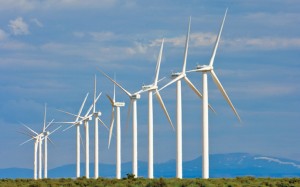 Republican politicians and their allies in the Trump administration may seem to be motivated by climate science “skepticism,” but their actions seem more about protecting favored polluting industries at the expense of clean ones.
Republican politicians and their allies in the Trump administration may seem to be motivated by climate science “skepticism,” but their actions seem more about protecting favored polluting industries at the expense of clean ones.
Take renewable energy: the costs have come down so dramatically that solar & wind, plus cheap natural gas, is out-competing coal, the favored Republican industry.
So how can Republicans try to privilege coal over renewables, in the face of market pressures? It’s unlikely that Congress will cooperate by eliminating federal tax credits for renewables that have strong bipartisan support (although it’s still a possibility with tax reform discussions looming — plus reduced corporate tax rates can undermine the tax credit incentives for renewables).
So that means the action has to fall on the regulatory side, specifically at the U.S. Department of Energy. We know that DOE appointees are trying to gut clean tech research and shut down all climate and clean energy programs.
But the new tack is to create a phony “study” of grid reliability and then use it to undermine solar and wind. The argument is that solar and wind, given that it relies on intermittent sources (sunshine and wind), will lead to blackouts and grid instability and cause grid failure. As E&E News reports on DOE secretary Rick Perry’s recent memo to this effect:
Boosted by “extremist political agendas,” according to Perry, renewable energy undermines baseload power that includes large coal and gas-fired generators, dams, and nuclear reactors. “Baseload power is necessary to a well-functioning electric grid,” Perry declared in the memo.
At least that’s the theory, and DOE appears set to write a study that proves that outcome. They can then use the study to invoke an obscure law that gives them emergency authority to freeze in place coal production at 30 percent of our nation’s supply, all in the name of securing grid reliability.
But the problem, as with so much of this pro-“brown power” ideology, is that the facts don’t support it. Here’s California Energy Commissioner David Hochschild and California Independent System Operator board of governor David Olsen in a pre-emptive strike in yesterday’s San Francisco Chronicle:
What happens when the wind doesn’t blow, or the sun doesn’t shine? To answer that question, one needs to examine the many countries that have more renewable energy than we do. Wind and solar contribute a share 2.5 times larger in Germany’s electricity mix (18.2 percent in 2016) than they do in the United States (6.9 percent). Germany produced 82 percent of its electricity from renewables for a period of several days in May. Denmark gets 100 percent of its electricity from renewables on many days of the year. Yet both nations have electric grids that are 10 times more reliable than America’s. Germany and Denmark average 23 and 24 minutes of customer outages per year respectively, while the United States averages 240 minutes per year.
The key to avoid reliability challenges is a diverse renewables mix, energy storage, and a regional grid, all features that many states in the U.S. already have or feasibly can have. So Perry’s study is unlikely to bolster his pro-coal (and pro-nuclear) case, unless he and his appointees are willing to cook the books.
As the secretary might say: “oops.”


